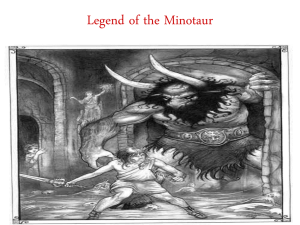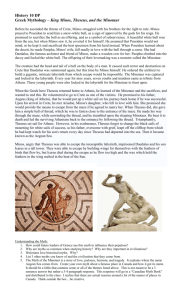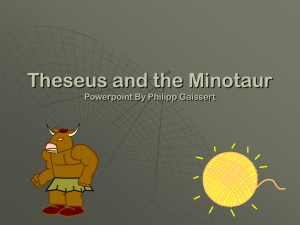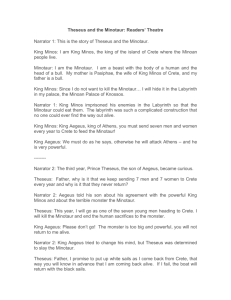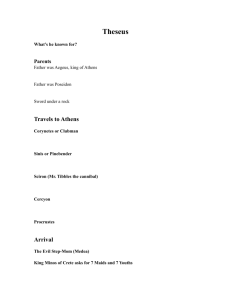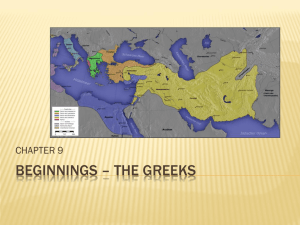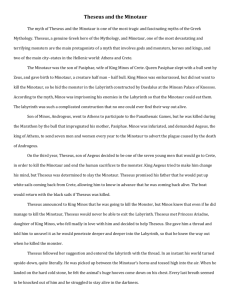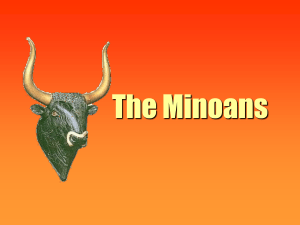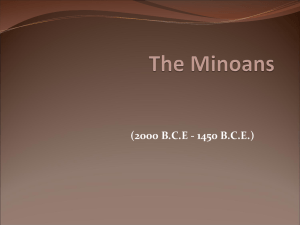The Minoans - International School of Sosua
advertisement
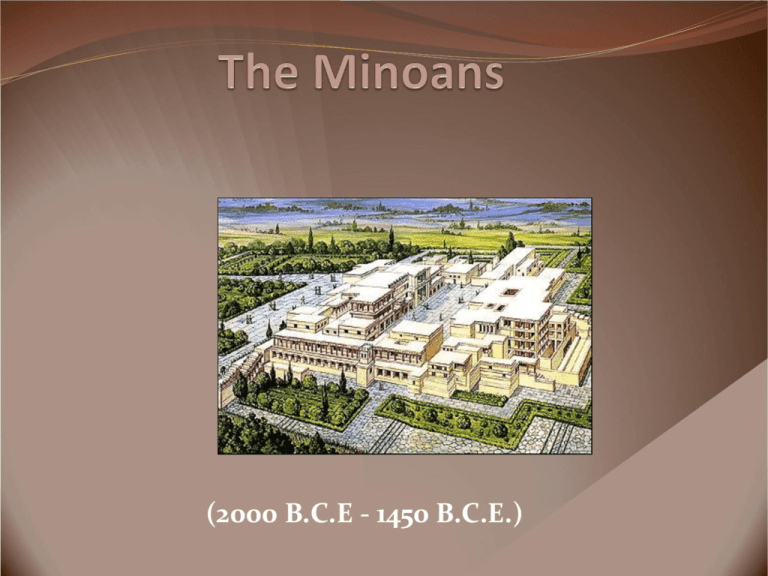
(2000 B.C.E - 1450 B.C.E.) The earliest civilization associated with Greece was on the island of Crete It is the largest island off mainland Greece. Knossos The famous Minoan civilization was discovered by Arthur Evans, He was an archeologist who discovered the remains of a palace at Knossos (1900-1905) Knossos This palace was thought to be the palace of King Minos alluded to in the writings of the ancient Greek historian Thucydides. The throne room at Knossos The Minoan civilization is named after King Minos who legend told, dominated a large part of the Aegean Sea with his powerful Navy. The queens apartment at Knossos His palace had over 800 rooms including apartments for the king & queen, a temple, workshops, and a school. The Palace Knossos It was also both government house & storehouse for taxes collected in the form of olive oil, wine, & grain. Cretans exported bronze utensils, olive oil, wine, and vases. They had indoor plumbing with piped in water and toilets. They developed systems of writing - Linear A, and Linear B. These scripts were discovered on clay tablets by Evans. The Palace Knossos The palace was decorated with frescoes depicting scenes of nature, Minoan life, and entertainment such as boxing and bull-leaping. The many roomed palace & images of bull-leaping may explain the Legend of the Minotaur. The myth of Theseus and the Minotaur Theseus, a Greek hero, and the Minotaur, a terrifying monster, are the main characters of a well known Greek myth. This myth involves gods and monsters, heroes and kings and two of the main city–states in the Greek world: Athens and Crete. The Origin of the Minotaur King Minos competed with his brothers to rule Crete. Minos prayed to Poseidon to send him a snow-white bull, as a sign of support. Minos was supposed to sacrifice the bull to show honor to Poseidon but decided to keep it instead because of its beauty. To punish Minos, Aphrodite made Pasiphae fall deeply in love with the bull. Pasiphae slept with the bull, and gave birth to Minotaur, a creature half man - half bull. King Minos was embarrassed, but did not want to kill the Minotaur, so he hid the monster in the Labyrinth at the Minoan Palace of Knossos. The Labyrinth According to the myth, Minos imprisoned his enemies in the Labyrinth so that the Minotaur could eat them. The labyrinth was such a complicated construction that no one could ever find the way out alive. Tribute of Aegeus Androgeus, the son of Minos, went to Athens to participate in the Panathenaic Games, but he was killed during the Marathon by the bull that impregnated his mother Pasiphae. Minos was infuriated, and demanded Aegeus the king of Athens to send seven men and women every year to the Minotaur to compensate for the grief caused by the death of his son. Theseus In the third year, Theseus, son of Aegeus decided to be one of the seven young men that would go to Crete. Theseus promised to kill the Minotaur and end the human sacrifices to the monster. King Aegeus tried to make him change his mind but Theseus was determined to slay the Minotaur. Theseus told his father that he would put up white sails coming back from Crete, letting him know in advance that he was coming back alive. The boat would return with the black sails if Theseus was killed. Princess Ariadne Upon arriving in Crete, Theseus met Princess Ariadne, daughter of King Minos, who fell madly in love with him and decided to help. She gave Theseus a thread and told him to unravel it as he would penetrate deeper and deeper into the Labyrinth, so that he would know the way out when he killed the monster. Theseus vs. the Minotaur Theseus followed her suggestion and entered the labyrinth with the thread. After a lengthy battle, Theseus managed to kill the Minotaur and save the Athenians, and with Ariadne's thread he managed to retrace his way out. Theseus took Princess Ariadne with him and left Crete sailing happily back to Athens. Aegeus and the Sails Theseus’ boat stopped at Naxos and the Athenians had a long celebration dedicated to Theseus and Ariadne. After long hours of feasting and drinking, Ariadne fell asleep on the shore and didn’t enter the boat that sailed to Athens. Theseus figured out that Ariadne was not with them when it was too late and he was so upset that he forgot the promise made to his father and did not change the sails. Suicide of Aegeus King Aegeus was waiting at the coast to see the sails of the boat. He saw the black sails from afar and presumed his son was dead. He dropped himself to the waters, committing suicide and since then, this sea is called the Aegean Sea. Minoans grew and prospered, but their civilization ended in 1450 B.C.E. A volcanic eruption on a nearby island may have been the cause. This may explain the legend of the lost continent of Atlantis.
